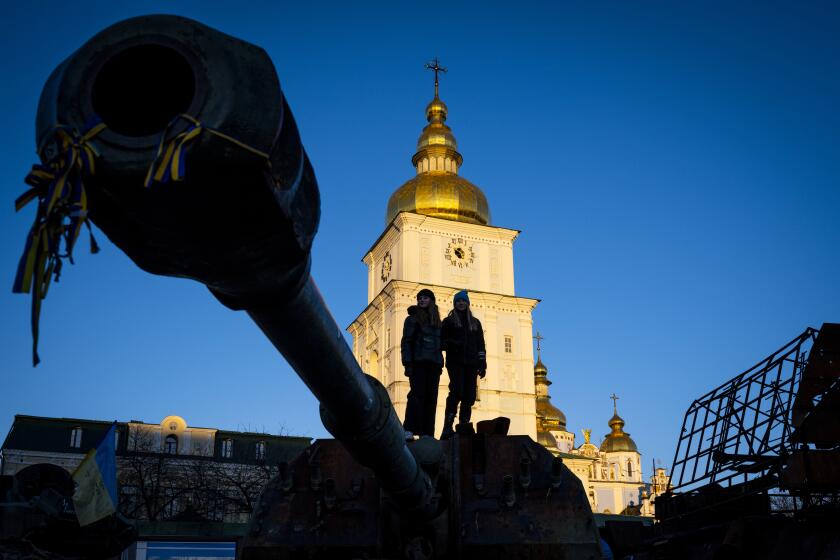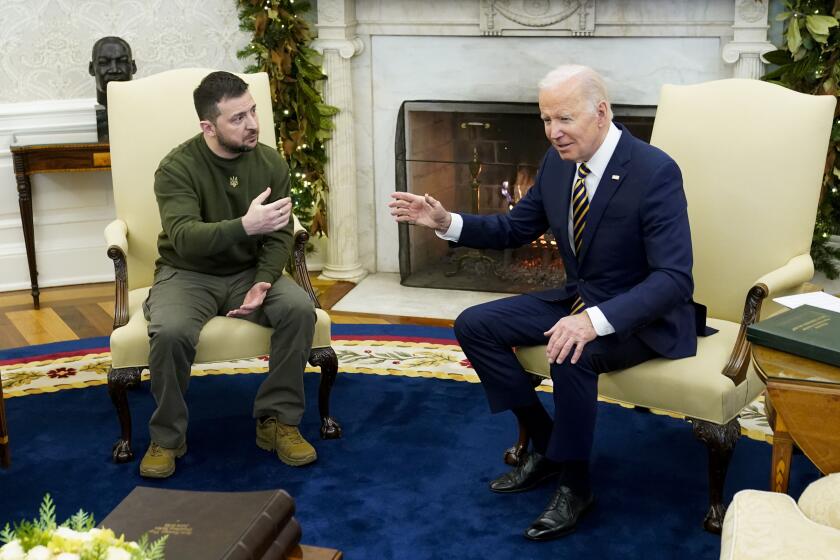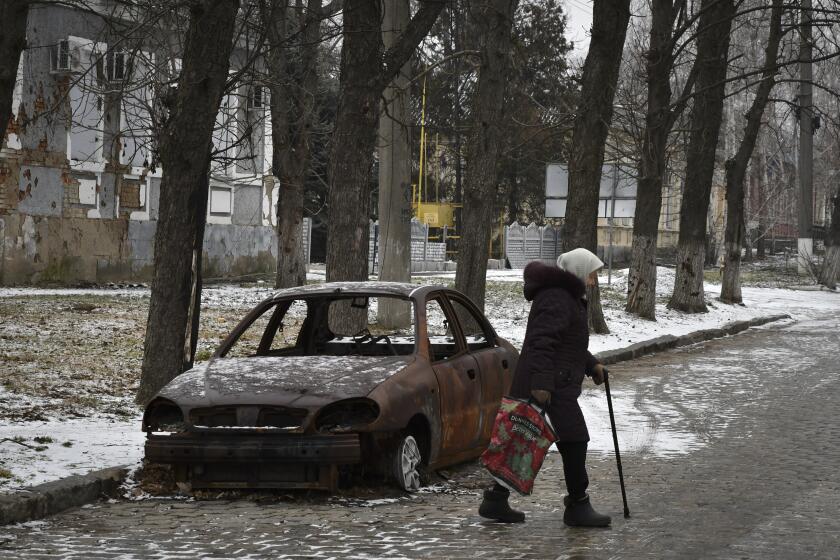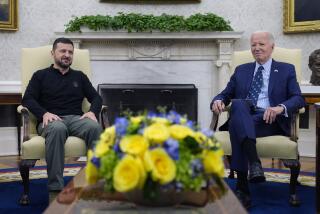Biden makes surprise Ukraine visit, pledging more U.S. aid as war’s anniversary nears

Even as air-raid sirens wailed, Biden met with Ukraine’s leader to pledge continued U.S. support, both moral and material, for Kyiv against Russia.
KYIV, Ukraine — President Biden secretly slipped into Kyiv on Monday for a historic visit to show U.S. solidarity with war-torn Ukraine, pledging an additional half-billion dollars in military aid and declaring Russian leader Vladimir Putin to be “dead wrong” in his underestimation of Western support and resolve.
Biden’s surprise visit, his first as president, comes four days ahead of the first anniversary of Moscow’s invasion of its neighbor, which has devastated parts of Ukraine but drawn fierce resistance and galvanized the West into pouring in assistance. In a reminder of the risks of such a trip, air-raid sirens wailed in Kyiv, the capital, during Biden’s visit.
The trip was an extraordinary logistical and security feat, marking the first occasion in modern times that an American president traveled to an active war zone not controlled by the U.S. military. And it involved notifying Russia amid raging hostilities between Washington and Moscow.
Arriving in Kyiv after a 10-hour overnight train ride from Poland, Biden appeared with Ukrainian President Volodymyr Zelensky at the heavily fortified presidential palace. Ukraine’s resilience over the last year, Biden proclaimed, had been “astounding,” and “the whole world sees it.” The U.S., he said, would support Kyiv “as long as it takes” to repel the Russian invasion, which began Feb. 24, 2022.
“That dark night one year ago, the world was literally bracing for the fall of Kyiv … perhaps even the end of Ukraine,” said Biden, clad in a suit with a blue and yellow tie — the colors of the Ukrainian flag. “One year later, Kyiv stands, and Ukraine stands. Democracy stands. … The world stands with you.”
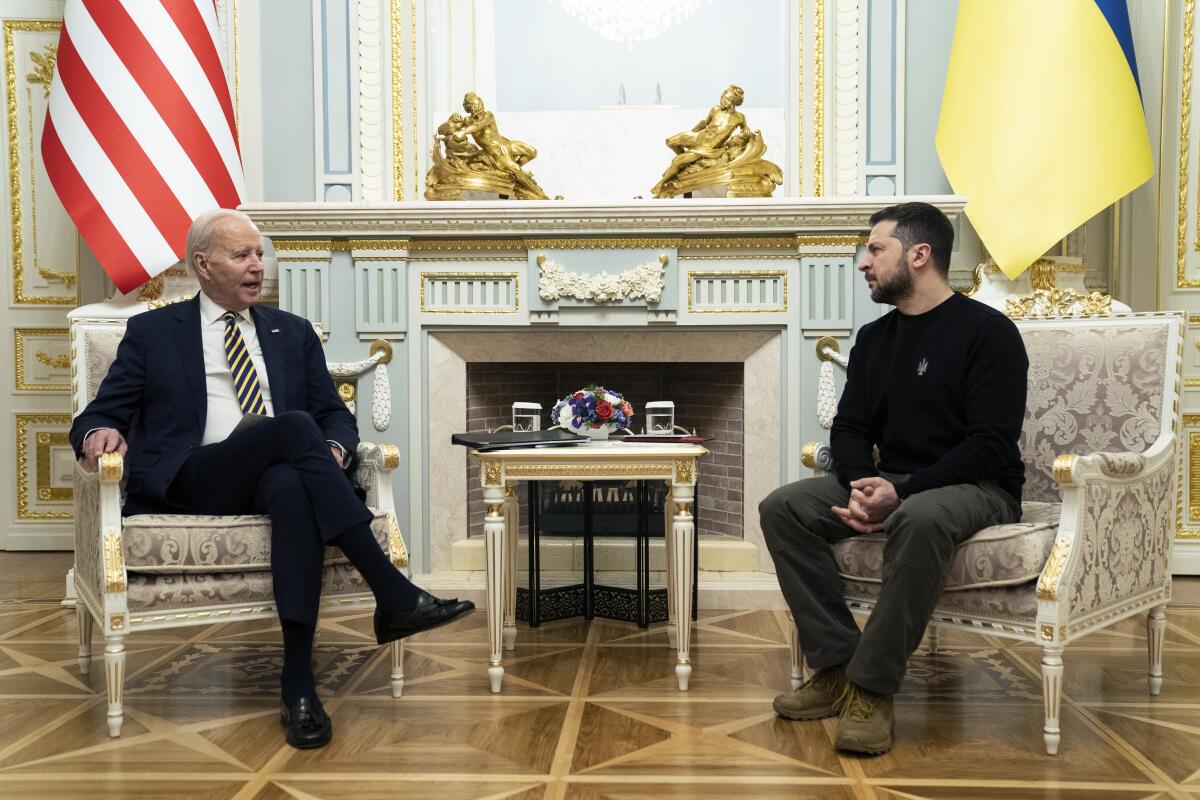
He noted that he had visited Ukraine six times as vice president during the Obama administration. “Kyiv has captured a part of my heart,” Biden said.
Zelensky, in his trademark dark sweatshirt, khaki pants and boots, embraced the U.S. president, calling the visit a “great honor” and thanking him for his leadership in marshaling the Western alliance supporting Ukraine.
In a statement issued by the White House after his arrival, Biden said the U.S. would make another delivery of critical equipment to Ukraine, including artillery ammunition, anti-armor systems and air-surveillance radars.
The new package includes $450 million for weapons, including ammunition for U.S.-provided HIMARS multiple-rocket launchers, Javelin antitank missiles and howitzers, armament that has significantly bolstered Ukraine’s firepower in recent months, and $10 million for repairing energy infrastructure, according to Secretary of State Antony J. Blinken. Air surveillance radars will also be included, he said.
War wounds and traumatic captivity, cherry liqueur and air-raid alerts: Weathering the year-old Russian invasion
Biden also said that additional economic sanctions on Russia were imminent. The U.S. and much of Europe have attempted to complicate Putin’s ability to finance the war by imposing sanctions on numerous Russian companies, officials and oligarchs.
“When Putin launched his invasion nearly one year ago, he thought Ukraine was weak and the West was divided. He thought he could outlast us. But he was dead wrong,” Biden said.
Biden arrived late Monday in Warsaw, where he will mark the anniversary of the invasion, meet with allies and deliver a major address on continued Western efforts to help Kyiv fend off Moscow’s forces. But there had been rumors that he might make an unannounced stop in Ukraine.
A year ago, President Biden braced for the worst as Russia amassed troops in preparation to invade Ukraine.
White House officials repeatedly denied the president would visit Ukraine, but planning for the covert trip had been under way for months. Only a handful of officials at the White House and Pentagon were made aware of the visit due to security concerns. Biden made the final decision to go to Kyiv on Friday during an Oval Office meeting after he was briefed on the security plans.
The president departed Washington in a smaller than usual Air Force jet at 4:15 a.m. Eastern on Sunday and had already crossed the Atlantic Ocean by the time an official White House schedule was released showing his planned departure on Monday. The lone two journalists allowed to travel on the president’s trip were sworn to secrecy and asked to hand over their phones, agreeing to withhold reporting on the president’s real-time movements until he left the war-ravaged country.
Biden and his small entourage of aides and security agents arrived in eastern Poland and boarded a six-car train bound for Kyiv. The local time was just after 9 p.m.
Similarly, previous high-level visitors have traveled by train from Poland. Ukrainian airspace has been closed since early in the war.
By the time he rolled into Kyiv around 8 a.m. local time Monday, Biden’s visit had still not been announced. But tangible indications of his presence trickled out in the center of a cold and sunny capital, where several major streets were blocked off by police barricades and devoid of their usual choking traffic, while black-clad officers in bulletproof vests turned passersby away. As word spread of a possible high-level U.S. visit, people clustered near the barricades, asking one another: “Biden?”
Their guess was confirmed when Biden, wearing aviator sunglasses, could be seen walking side by side with Zelensky near a memorial wall bearing the photographs of fallen Ukrainian soldiers.
Bystanders were surprised and largely delighted.
“He’s a hero! It’s quite risky, don’t you agree?” said Galyna Reshetnyk, 40, who learned of Biden’s presence when she emerged from the subway a few blocks from where he and Zelensky had their brief walkabout. “And this air alert — life here is difficult, and he will see that for himself.”
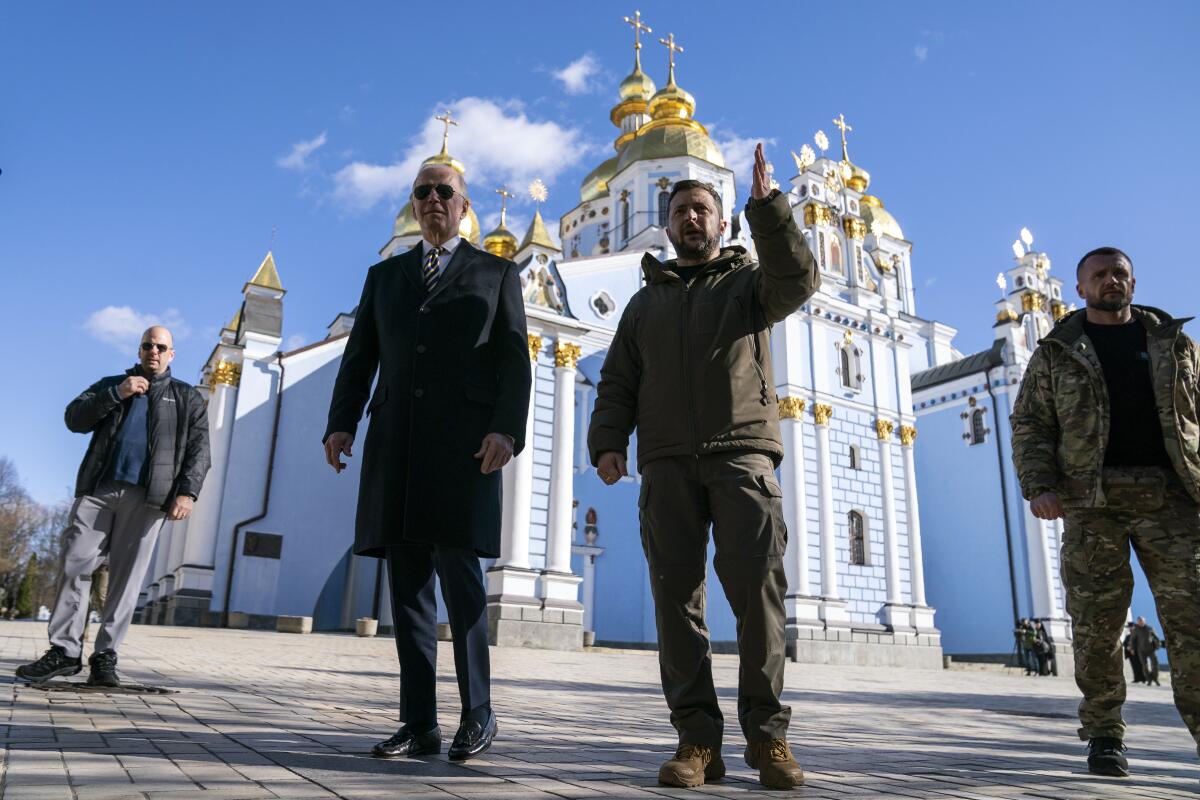
The hubbub in downtown Kyiv centered on the landmark St. Michael’s monastery, dedicated to the archangel Michael. For months, the broad plaza in front of the golden-domed complex has contained a display of rusting, half-ruined Russian tanks and armored vehicles, a popular attraction in the wartime capital. The area surrounding the U.S. Embassy was blocked off as well.
Jake Sullivan, the head of Biden’s National Security Council, said U.S. officials had informed Russian authorities of the trip just hours before Biden’s departure for “de-confliction purposes,” meaning to forestall a Russian attack, deliberate or accidental, on the president or his entourage. Sullivan did not report on any response from Moscow.
The trip “required a security, operational and logistical effort from professionals across the U.S. government to take what was an inherently risky undertaking and make it a manageable level of risk,” Sullivan said.
Biden was “quite focused” on how he and Zelensky “were really going to look out over the course of 2023 and try to come to a common understanding of what the objectives are,” said Sullivan, who briefed reporters by telephone after Biden departed Kyiv about 1 p.m. local time.
The president spent roughly five hours in Kyiv, which included talks with Zelensky. He walked the streets of the capital and made a stop at the U.S. Embassy.
Breaking News
Get breaking news, investigations, analysis and more signature journalism from the Los Angeles Times in your inbox.
You may occasionally receive promotional content from the Los Angeles Times.
Biden’s secrecy-shrouded trip comes after the heads of other NATO nations, including the leaders of Britain, France and Germany, have all made their own pilgrimages to Kyiv to express their support for the effort to repel Russia’s invasion. But Biden’s visit is the strongest signal yet of Western solidarity with Ukraine, and comes as Zelensky girds his country for heavier fighting to come.
The president had not previously traveled to Ukraine out of security concerns, but several high-ranking officials have made the trip. Blinken and Defense Secretary Lloyd J. Austin III traveled to Kyiv in April, and First Lady Jill Biden made a surprise Mother’s Day visit to western Ukraine in May.
Zelensky has been unwavering in his quest for more weaponry from Ukraine’s backers to try to turn the tide of the war. He has succeeded in receiving pledges of tanks, once considered a no-go by the likes of Germany, and is now pressing for F-16 fighter jets and other advanced weapons systems in preparation for an expected Russian offensive in the spring. The Biden administration has so far resisted sending warplanes that require complex training, but White House officials haven’t ruled it out.
Ukraine wants the kind of heavy weaponry that would allow it to launch a spring offensive and regain much-needed battlefield momentum.
Biden’s visit to an active war zone represented a bold gesture of support at a time when U.S. public backing for billions of dollars in military aid remains strong, but has waned somewhat since the war’s early months. Some far-right congressional Republicans have demanded cutbacks in aid.
Presidents Obama, George W. Bush and Trump took trips during their tenures to Iraq and or Afghanistan, places that were technically war zones. However, in each case, there was a massive presence of U.S. troops in those countries, the U.S. controlled airspace and the presidents remained in the confines of fortified U.S. military installations.
The possibility of providing Kyiv with fighter jets to help beat back Russia’s invasion risks the unity of Ukraine’s Western allies.
Biden’s visit to a city still under periodic attack reflected his determination to rally and maintain commitment in the U.S. and Europe to support Ukraine, as well as the administration’s confidence in Kyiv as a partner.
Ukraine’s foreign minister, Dmytro Kuleba, wrote on Facebook that the visit showed the “trusting and sincere” relationship between the United States and Ukraine, calling it a “victory for the Ukrainian people.”
Steven Pifer, a former U.S. ambassador to Ukraine, said the trip was a “strong signal of U.S. support for Ukraine,” with the added significance of its coming on the eve of the anniversary of the Russian invasion.
A bloody stalemate currently prevails on the front lines in Ukraine’s east, hundreds of miles from Kyiv. Russian forces have been attempting to mount an offensive near beleaguered Bakhmut but have not managed to seize the town — a prize many thought Putin would try to brandish in time for the invasion’s anniversary Friday.
Many Ukrainians are on edge, anticipating the possibility of a major air attack on Kyiv. Moscow’s forces for months have been targeting Ukrainian cities and infrastructure with rockets, drones and missiles, although the latest such attack on Kyiv was more than a week ago.
Since October, Russia has launched more than a dozen waves of strikes aimed at crippling Ukraine’s power grid with the onset of winter, but in the capital, at least, that effort seems to have largely fizzled, with outages becoming a relative rarity. In addition, the winter has been a fairly mild one, frustrating the Kremlin’s effort to sap morale by leaving Ukrainians in the cold and dark.
King reported from Kyiv, Subramanian from Warsaw and Wilkinson from Washington.
More to Read
Get the L.A. Times Politics newsletter
Deeply reported insights into legislation, politics and policy from Sacramento, Washington and beyond. In your inbox three times per week.
You may occasionally receive promotional content from the Los Angeles Times.
